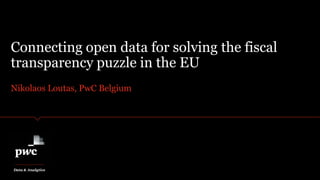
Connecting Open Data for Fiscal Transparency
- 1. Nikolaos Loutas, PwC Belgium Connecting open data for solving the fiscal transparency puzzle in the EU Data & Analytics
- 2. Achieving Open Data objectives is more complex than expected Create value for the user community It’s about quality …not quantity Fundamental drivers of open data ▪ Transparent administration ▪ New business models
- 3. Open data for transparency State of play 2016 3Source: https://opendatabarometer.org/4thedition/report/#open_data_trends
- 4. Looking into the case of EU fiscal data, including the EU Budget and the Financial Transparency System
- 5. It’s much more than putting the data online Understand- ability Terminology and structure are difficult to understand. Understanding how the data has been created. Scattered information EU Budget, MFF, FTS, etc. The pieces need to be connected. Low usability & interoper- ability Data is not interpreted in the same way, e.g. FTS data is not exactly spending data. Data is not in the right format, has no licence, or is not machine-readable. Meeting users needs & expectations in terms of access, format, focus, granularity, etc. Answering the burning questions, and presenting data in the right way. Quality Data is of uncertain quality, timeliness or provenance. The users cannot trust it. In cases such as the EU Budget, there’s no room for mistakes, because of political implications.
- 6. Connecting data and telling stories around it Harmonised vocabularies and codelists Dissemination vocabularies & data dictionaries, e.g. for the MFF, that help express the meaning of the data and is made openly available, and is implemented in the data production systems. Linked datasets ... connecting data from different sources to build a complete picture, in this case EU Budget, spending, FTS, company registers… Data as a service Allow users to query and retrieve the right data at the right time in the right format, ideally from one point of access. Story telling Engaging the users not only for making sure that the right data is available, but also for identifying the right questions and creating stories from the data Manage the data lifecycle Putting once the data online is not enough…make sure that your data is kept fresh, and continuously improved.
- 7. Who receives the money of the EU Budget? “ 7 In which countries are recipients located? “ Example Linking EU Budget & Spending
- 8. Who receives the money of Horizon 2020? “ 8 Under which contracts and EU budget lines? “ Example Linking EU Budget & Spending
- 9. Thank you! Disclaimer The views expressed in this report are purely those of the authors and may not, in any circumstances, be interpreted as stating an official position of the European Commission. The European Commission does not guarantee the accuracy of the information included in this study, nor does it accept any responsibility for any use thereof. Reference herein to any specific products, specifications, process, or service by trade name, trademark, manufacturer, or otherwise, does not necessarily constitute or imply its endorsement, recommendation, or favouring by the European Commission. All care has been taken by the author to ensure that s/he has obtained, where necessary, permission to use any parts of manuscripts including illustrations, maps, and graphs, on which intellectual property rights already exist from the titular holder(s) of such rights or from her/his or their legal representative. This work has been funded under the ISA and ISA² Programmes of the European Commission. https://joinup.ec.europa.eu/solution/eu-budget-vocabulary
